247 scholarly books by University Press of New England and 18
have author last names that start with C
247 scholarly books by University Press of New England and 18
247 scholarly books by University Press of New England
18 have author last names that start with C have author last names that start with C
18 have author last names that start with C have author last names that start with C
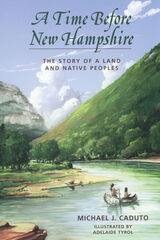
A Time Before New Hampshire
The Story of a Land and Native Peoples
Michael J. Caduto
University Press of New England, 2004
In this masterful and elegant book, Michael J. Caduto tells the complete story of the land of New Hampshire—starting with the formation of earth 4.6 billion years ago and continuing with changes to its peoples and the environment through the seventeenth century. Part I offers a comprehensive look at every aspect of the ancient natural world—including geology, glaciology, botany, climatology, ecology, zoology, and paleobotany. It describes the formation of the land hundreds of millions of years ago as a result of major movements in the tectonic plates; chronicles the rise and fall of reptiles, mammals, birds, and plants and other life forms stemming from climatic changes; and explores the arrival of human beings during and after the relatively recent ice age. The rest of the volume immerses the reader in the history of the human populations in New Hampshire, beginning with the Paleoindian period of hunter gatherers over twelve thousand years ago and continuing through the arrival of horticulture among the Alnôbak (Abenaki) and beyond. Caduto explores the Alnôbak’s day-to-day existence, culture, and traditional tales as preserved by archeologists, anthropologists, historians, and living cultures. Emphasizing the beliefs, cultures, and practices of these native people, Caduto details the Alnôbak’s relationship to the natural world as he tells the story of coevolution between the land and people through time. Caduto takes the reader on an exploration through New Hampshire’s rich and diverse history—using first-hand experiences, re-creations of natural and human environments, journeys through historical landscapes and visits with the families of ancient people—to present a thorough profile of the early beginnings of the Granite State. The volume features an epilogue by Charlie True, Member of the Tribal Council, Abenaki Nation of New Hampshire, and nearly one hundred photographs, illustrations, and detailed maps depicting past peoples, historical trails, and indigenous cultures and environments of New Hampshire.
[more]

Pond and Brook
A Guide to Nature in Freshwater Environments
Michael J. Caduto
University Press of New England, 1990
Designed specifically for the amateur naturalist and filled with hands-on projects and activities, Pond and Brook introduces the readers to the intriguing world of freshwater life. Michael Caduto’s keen eye investigates all common freshwater environments, from wetlands and deep lakes to streams and vernal ponds. An important feature of the book is its holistic approach to both living and non-living components of freshwater environments, and how they fit together to weave an ecological whole. Readers will learn the unique properties of water, the basic principles vital to understanding aquatic life, and the origin of freshwater habitats.
[more]
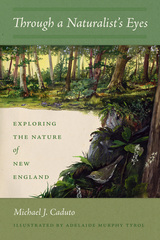
Through a Naturalist's Eyes
Exploring the Nature of New England
Michael J. Caduto
University Press of New England, 2016
For native and visitor alike, the New England landscape has a rich allure. This grand sweep of land is a living tapestry woven of interconnected bioregions and natural communities whose compositions of plants and animals have evolved over time. In more than fifty essays, Michael J. Caduto brings readers into the complex stories to be found in nature. Drawing on first-hand experiences and reflections on the relationship between the natural world and humans, Caduto explores some of the plants, animals, natural places, and environmental issues of New England—from dragonflies, cuckoos, and chipmunks to circumpolar constellations and climate change. Stunning illustrations by Adelaide Murphy Tyrol illuminate these elegant and humorous essays.
[more]
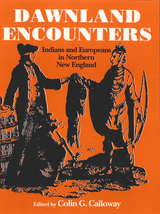
Dawnland Encounters
Indians and Europeans in Northern New England
Colin G. Calloway
University Press of New England, 1991
Colin G. Calloway collects, for the first time, documents describing the full range of encounters of Indians and Europeans in northern New England during the Colonial era. His comprehensive and highly readable introduction to the subject of Indian and European interaction in northern New England covers early encounters, missionary efforts, diplomacy, war, commerce, and cultural interchange and features a wide range of primary sources, including narratives, letters, account books, treaties, and council proceedings. Together with period illustrations, the documents testify to the richness and variety of the inter-ethnic relations in northern New England. They also show that while conflict certainly occurred, the encounters were also marked by cooperation and accommodation.
[more]
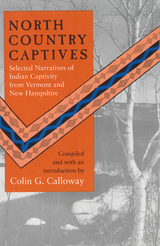
North Country Captives
Selected Narratives of Indian Captivity from Vermont and New Hampshire
Colin G. Calloway
University Press of New England, 1992
Revealing firsthand narratives of Indian captivity from eighteenth-century New Hampshire and Vermont. Narratives of Europeans who experienced Indian captivity represent one of the oldest genres of American literature. They are often credited with establishing the stereotype of Indians as cruel and bloodthirsty. While early southern New England accounts were heavily influenced by a dominant Puritan interpretation which had little room for individual and cultural distinctions, later northern New England narratives show growing independence from this influence. The eight narratives selected for this book challenge old stereotypes and provide a clearer understanding of the nature of captive taking. Indians used captives to replace losses in their tribes and families, and also to participate in the French and British ransom market. These stories portray Indian captors as individuals with a unique culture and offer glimpses of daily life in frontier communities. Calloway complements them with valuable historical background material. His book will appeal especially to readers interested in Native American peoples and life on the north country frontier of Vermont and New Hampshire.
[more]

Maturing with Moxie
A Woman’s Guide to Life after 60
Jan Cannon
University Press of New England, 2018
Whether widowed, divorced, married, or single, more and more women of retirement age are taking control of their lives. Maturing with Moxie takes a close look at personal and professional circumstances affecting women over sixty by surveying the best and latest thinking on issues from housing to health care, finances to family, and combines them all in one practical, go-to volume. The veteran consultant Jan Cannon takes a comprehensive approach to a range of decisions facing women as they age, and offers sensible, helpful advice on everyday questions about employment, Medicare, changing family dynamics, and dating. Drawing on her extensive client case files, Cannon poses provocative questions, designs useful exercises, and offers clear, upbeat examples of women moving forward with purpose. Maturing with Moxie gives women a wealth of resources for finding the answers they need.
[more]
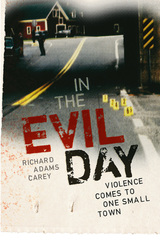
In the Evil Day
Violence Comes to One Small Town
Richard Adams Carey
University Press of New England, 2015
On the afternoon of August 19, 1997, John Harrigan—owner and publisher of the News and Sentinel newspaper in Colebrook, New Hampshire—arrived at his building to find the woman he loved lying dead in the parking lot. Lawyer Vickie Bunnell had been shot and killed by a local carpenter wielding an assault rifle. By then, three more people were already dead or dying. More mayhem was to ensue in an afternoon of plot twists too improbable for a novel. The roots of the incident stretch back twenty-five years, with tendrils deep in the history of New England’s North Country. These bloody events shocked America and made headlines across the world. Hundreds of local citizens became unwilling players in the drama—friends and colleagues of the dead, men and women who were themselves real or potential targets, along with their neighbors in law enforcement—but the town and its inhabitants were never passive victims. From the first shot fired that day, they remained courageously determined to survive. This is the story of that town, those people, and that day. In the Evil Day is a moving portrait of small-town life and familiar characters forever changed by sudden violence.
[more]
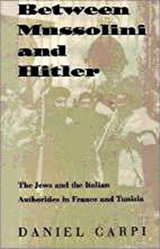
Between Mussolini and Hitler
The Jews and the Italian Authorities in France and Tunisia
Daniel Carpi
University Press of New England, 2002
The Nazi invasion of Poland in 1939 plunged the world into its second global conflict. The Third Reich's attack, mounted without consulting its Italian ally, had other reverberations as well. Chief among them was Mussolini's decision to conduct a "parallel war" based on his own tactical and political agendas. Against this backdrop, Daniel Carpi depicts the fate of some 5000 Jews in Tunisia and as many as 30,000 in southeastern France, all of whom came under the aegis of the Italian Fascist regime early in the war. Many were unskilled immigrants: still others were political refugees, activists, or anti-fascist emigres, the fuoriusciti who fled oppression in Italy only to find themselves under its rule once again after the fall of France. While the Fascist regime disagreed with Hitler's final solution for the "Jewish problem," it also saw actions by Vichy French police or German security forces against Jews in Italian-controlled regions as an erosion of Rome's power. Thus, although these Jews were not free from oppression, Carpi shows that as long as Italy maintained control over them its consular officials were able to block the arrests and mass deportations occurring elsewhere.
[more]
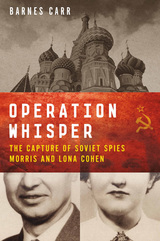
Operation Whisper
The Capture of Soviet Spies Morris and Lona Cohen
Barnes Carr
University Press of New England, 2016
Meet Morris and Lona Cohen, an ordinary-seeming couple living on a teacher’s salary in a nondescript building on the East Side of New York City. On a hot afternoon in the autumn of 1950, a trusted colleague knocked at their door, held up a finger for silence, then began scribbling a note: Go now. Leave the lights on, walk out, don’t look back. Born and raised in the Bronx and recruited to play football at Mississippi State, Morris Cohen fought for the Loyalists in the Spanish Civil War and with the U.S. Army in World War II. He and his wife, Lona, were as American as football and fried chicken, but for one detail: they’d spent their entire adult lives stealing American military secrets for the Soviet Union. And not just any military secrets, but a complete working plan of the first atomic bomb, smuggled direct from Los Alamos to their Soviet handler in New York. Their associates Julius and Ethel Rosenberg, who accomplished far less, had just been arrested, and the prosecutor wanted the death penalty. Did the Cohens wish to face the same fate? Federal agents were in the neighborhood, knocking on doors, getting close. So get out. Take nothing. Tell no one. In Operation Whisper, Barnes Carr tells the full, true story of the most effective Soviet spy couple in America, a pair who vanished under the FBI’s nose only to turn up posing as rare book dealers in London, where they continued their atomic spying. The Cohens were talented, dedicated, worldly spies—an urbane, jet-set couple loyal to their service and their friends, and very good at their work. Most people they met seemed to think they represented the best of America. The Soviets certainly thought so.
[more]
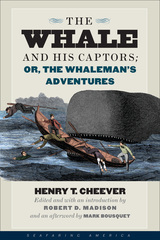
The Whale and His Captors; or, The Whaleman's Adventures
Henry T. Cheever
University Press of New England, 2018
The Whale and His Captors is an important firsthand account of the golden age of American whaling, chronicling both its lore and science as practiced from the inception of the fishery to the mid-1800s. Late in the composition of Moby-Dick, Herman Melville found inspiration in Cheever and his writings that would provide the final flourishes for one of America’s classic novels. After exhausting other whaling sources—Beale, Scoresby, Bennett, and Browne—Melville turned to Cheever for chapter titles and organization as well as passages that helped shape, define, and elucidate his great work. This is the first scholarly edition of The Whale and His Captors, accompanied by an introduction and apparatus that clearly elucidates Cheever’s treatise on whaling and demonstrates how his writings contributed both to the course of American literature and to our burgeoning understanding of literature’s engagement with the natural world.
[more]
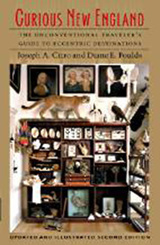
Joseph E. Citro
University Press of New England
New England is truly a Cabinet of Curiosities, and this indispensable guide directs you to its most bizarre, off the wall, and unsettling exhibits. Some evoke hilarity, some horror. Discover singing sand, glowing tombstones, ghostly squirrels, and a musical instrument said to cause madness. Marvel at the most mysterious manuscript in the world. Visit a miniature replica of the Holy Land or climb carved stone steps leading . . . nowhere. Curious New England points the way to all the tantalizing treats and terrifying treasures that remain tucked away in overlooked museums, private collections, and forgotten recesses of this very special region. *A cursed statue in Maine *Ageless American Megaliths *A window embedded in Vermont earth *Titus’s Arch on a New Hampshire hilltop *Artwork made from insect parts With precise directions, hours, and contact information, these fascinating pages reveal each mystery, miracle, and marvel, from world-class weirdness, to minor curiosities, to entertaining distractions. There'll be no more boring Sunday drives when you can visit a spider farm, explore the laboratory of “mad” scientist Wilhelm Reich, view the Hobo Hotel, and observe houses made from paper, wooden crates, mounds of earth—even covered bridges. And New England’s wonders never cease: discover evidence of manned flight a century before the Wright Brothers; visible phantoms manifesting from marble columns; and automobiles emerging from tarmac like dinosaurs from pits of tar. This one-of-a-kind collection spotlights all six New England states, illuminating everything that’s wicked, weird, and wonderful in every hidden corner of a region that rivals Old England in mysteries, miracles, and marvels.
[more]
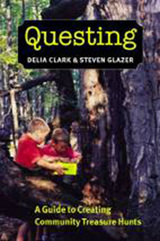
Questing
A Guide to Creating Community Treasure Hunts
Delia Clark
University Press of New England, 2006
Inspired by the British pastime of "letterboxing," questing has become one of the fastest growing recreational-educational activities on this side of the Atlantic. In scores of communities, people from toddlers and teens, parents and grandparents follow maps, clues, and rhyming riddles seeking treasure boxes hidden in natural and cultural locations. In this book, two experts in community education explain how individuals and organizations can create and organize permanent quests to foster place-based education, stewardship, adventure, and fun. In the process of undertaking quests participants "celebrate and strengthen community life" by forging "lifelong connections to the distinct landscapes and cultural features of their home ground." This book is intended to offer inspiration and practical advice for parents, teachers, community group leaders, and others interested in learning about where they live and building community ties through questing. Questing draws upon the well-established success of a program in New England in which individuals, students, and organizations create clues and maps highlighting the special places and stories of their community. The book presents a rationale for place-based education and quest program goals and objectives that can easily be implemented in any community.
[more]
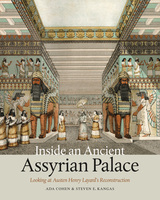
Inside an Ancient Assyrian Palace
Looking at Austen Henry Layard's Reconstruction
Ada Cohen
University Press of New England, 2016
One of the best-known images of the ancient Near East is an intriguing nineteenth-century color lithograph reconstructing the throne room of an Assyrian palace. Executed shortly after the archaeological rediscovery of Assyria, a land theretofore known only from the Bible, it was published by the most famous among early excavators of Assyrian ruins, Austen Henry Layard. Over time and despite criticisms, the picture has shaped the understanding and reception of ancient Mesopotamian architecture and architectural decoration. Inside an Ancient Assyrian Palace studies this influential image in depth, both at the time of its creation in London in the eventful year 1848 and in terms of its afterlife. A hidden inscription reveals unsuspected contributions by the renowned architect-designer Owen Jones and his colleague the architect-Egyptologist Joseph Bonomi. Also unexpected is the involvement of an enigmatic German artist who later emigrated to America and whose previous career in Europe had been lost to scholarship. This book will be of interest to scholars and students of art history and the ancient Near East. It will also be of relevance to museum visitors and others interested in the ancient world in general, in the art of the nineteenth century, and in design and historical reconstruction.
[more]
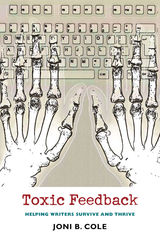
Joni Cole
University Press of New England
All writers have stories of how some teacher, workshop participant, friend, or spouse gave them commentary that undermined their confidence and their writing. This “toxic feedback” has tainted feedback's reputation as a whole, causing too many writers to avoid or mismanage this valuable resource. In the first book to focus on this vital but delicate dynamic, Joni B. Cole applies first-person experience, real-life teaching examples, and her own unique ability to entertain while reaffirming the many merits of feedback. Cole shows writers how to use feedback to energize and inform their writing at every stage of the process. For feedback providers, she delivers insights into constructive criticism and the difference between being heard and being obnoxious. Finally, she offers advice to workshops and critique groups on how to thrive in this collective experience. In addition, established writers ranging from Julia Alvarez and Khaled Hosseini to Gregory Maguire and Jodi Picoult share their own feedback stories -- from useful to inspiring to deranged -- underscoring Cole's message that feedback plays a critical role in every writer's success. Through a mixture of instruction, anecdotes, and moral support, Cole manages to detoxify the feedback process with humor and without laying blame, inspiring both sides of the interaction to make the most of this powerful resource.
[more]
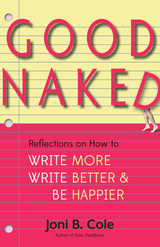
Joni B. Cole
University Press of New England
In Good Naked, acclaimed author Joni B. Cole shows readers how to make the writing process not only more productive, but less maddening, more inviting, and even joyful, at least a good part of the time. She explains how sharing early drafts is “good naked”—you’re exposing your creative process in all its glory. Through a mix of engaging stories and practical wisdom, all delivered with sheer good humor, Cole addresses the most common challenges writers confront and offers disarmingly simple but effective solutions. She debunks popular misconceptions about how we are supposed to write and replaces them with strategies that actually work to get us started and stay motivated. (Searching for your muse? Try looking in the fridge.) With a do-this-not-that directness, she sets writers free from debilitating attitudes, counterproductive practices, and energy-draining habits that undermine confidence and creativity. Equipped with experience and a refreshing respect for anyone who wants to write, Cole also infuses every chapter with insights into craft and narrative technique—because the truly happy ending is not just that we write more, but that we write well. If you have ever experienced a sense of dread or intimidation at any stage of the creative process, or even if you simply want to write more, write better, and be happier, this intelligent, funny, and generous guide will not only inspire you to head over to your desk, but will also cheer you on once you’re there.
[more]
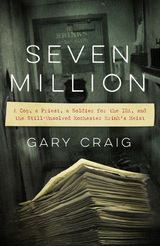
Seven Million
A Cop, a Priest, a Soldier for the IRA, and the Still-Unsolved Rochester Brink's Heist
Gary Craig
University Press of New England, 2017
On a freezing night in January 1993, masked gunmen walked through the laughably lax security at the Rochester Brink’s depot, tied up the guards, and unhurriedly made off with $7.4 million in one of the FBI’s top-five armored car heists in history. Suspicion quickly fell on a retired Rochester cop working security for Brinks at the time—as well it might. Officer Tom O’Connor had been previously suspected of everything from robbery to murder to complicity with the IRA. One ex-IRA soldier in particular was indebted to O’Connor for smuggling him and his girlfriend into the United States, and when he was caught in New York City with $2 million in cash from the Brink’s heist, prosecutors were certain they finally had enough to nail O’Connor. But they were wrong. In Seven Million, the reporter Gary Craig meticulously unwinds the long skein of leads, half-truths, false starts, and dead ends, taking us from the grim solitary pens of Northern Ireland’s Long Kesh prison to the illegal poker rooms of Manhattan to the cold lakeshore on the Canadian border where the body parts began washing up. The story is populated by a colorful cast of characters, including cops and FBI agents, prison snitches, a radical priest of the Melkite order who ran a home for troubled teenagers on the Lower East Side of Manhattan, and the IRA rebel who’d spent long years jailed in one of Northern Ireland’s most brutal prisons and who was living underground in New York posing as a comics dealer. Finally, Craig investigates the strange, sad fate of Ronnie Gibbons, a down-and-out boxer and muscle-for-hire in illegal New York City card rooms, who was in on the early planning of the heist, and who disappeared one day in 1995 after an ill-advised trip to Rochester to see some men about getting what he felt he was owed. Instead, he got was what was coming to him. Seven Million is a meticulous re-creation of a complicated heist executed by a variegated and unsavory crew, and of its many repercussions. Some of the suspects are now dead, some went to jail; none of them are talking about the robbery or what really happened to Ronnie Gibbons. And the money? Only a fraction was recovered, meaning that most of the $7 million is still out there somewhere.
[more]
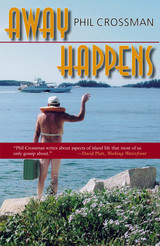
Phil Crossman
University Press of New England
“Several years ago it was revealed to me that creative nonfiction was a legitimate literary genre,” writes Phil Crossman. “It was the most liberating experience of my life. All these years I thought I’d been simply lying.” Crossman is a humorist in the Mark Twain mold: wry, satiric, and keenly aware of the shortcomings of human beings, but with a leavening of self-deprecation and underlying sympathy. Though rooted in a regional consciousness (coastal Maine), his humor succeeds in making the local universal. Away Happens considers daily life on an island in Penobscot Bay that supports both a tight-knit local community and a larger seasonal population. Whether he is recounting a debate that happened at the Lions Club over who counts as a “local” or describing his adventures getting the Thanksgiving turkey into the oven, ruminating on how the ferry schedule shapes island life or recalling a local crime spree, Crossman is funny, unsentimental, and authentically Maine. “There are only two places, Here, this island off the coast of Maine, and Away. Here, this place, is a small place and Away, everywhere else, is a big place, but make no mistake about it, Here is Here and Away is not. 1276 people live Here. Billions more live Away than live Here, although increasingly, during the summer, it seems otherwise.” —From the Book
[more]

The Good Beer Guide to New England
Andy Crouch
University Press of New England, 2006
With wit, enthusiasm, and a deep respect for the craft of brewing, Andy Crouch profiles nearly one hundred establishments in New England, offering a description and history of each, as well as insights into each brewmaster's philosophy and brewing style. For each brewery and brewpub profiled, Crouch covers the range of beers available and identifies its flagship product; he also highlights his choice for its “best beer,” which is rarely its most popular or best known offering. Crouch offers judicious evaluations of food, ambience, and of course, the beer; he also provides information on the availability of tours, directions and parking, hours of operation, entertainment, local sights of interest, and whether beer is available for take-away. In addition, he includes essays on the brewing process, understanding and appreciating beer, and a list of “eleven great New England beer bars.” Whether well-brewed beer is the focus of a trip or a welcomed complement, beer enthusiasts and novices alike will find this guide a worthwhile companion wherever they travel in New England.
[more]
READERS
Browse our collection.
PUBLISHERS
See BiblioVault's publisher services.
STUDENT SERVICES
Files for college accessibility offices.
UChicago Accessibility Resources
home | accessibility | search | about | contact us
BiblioVault ® 2001 - 2024
The University of Chicago Press









